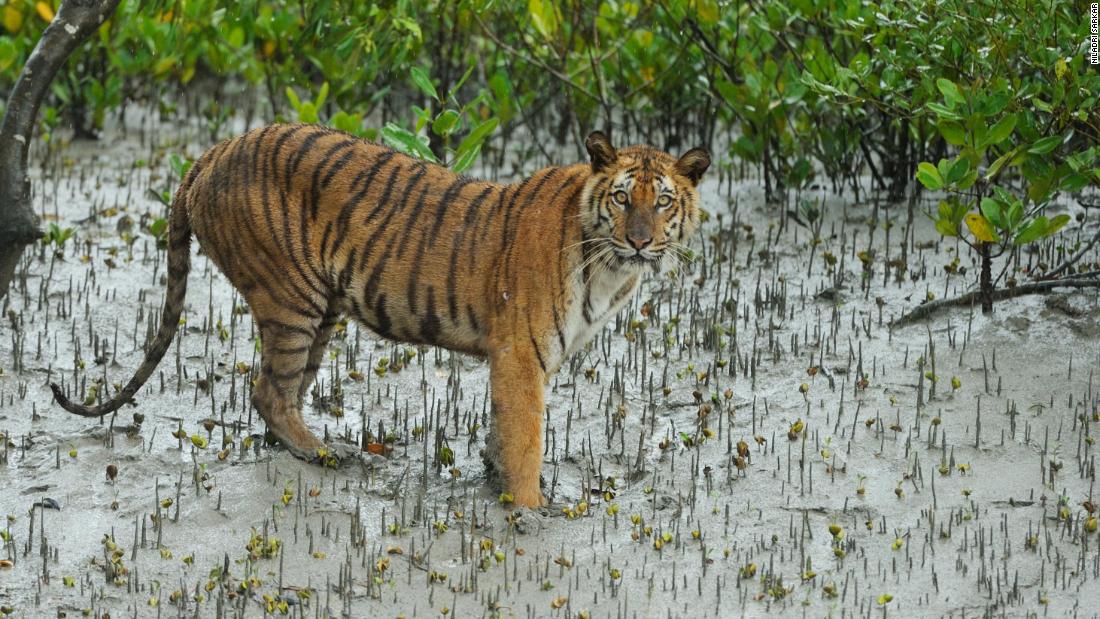Bengal tigers could vanish from one of their final strongholds

Already threatened by poaching, and humans spreading into its shrinking habitats, researchers say that in just 50 years it could completely disappear from one of its last remaining strongholds — a huge mangrove forest called the Sundarbans, which crosses India and Bangladesh.Over the past century, we’ve lost 95% of all the world’s tigers, leaving less than 4,000 in the wild. Bengal tigers are found in a handful of Asian countries, but just a few hundred still roam free in the Sundarbans.Covering more than 10,000 square kilometers, the low-lying area is shrinking rapidly, with some of its islands submerging as local sea levels rise much faster than the global average.Read: The most effective way to fight climate change? Between 2004 and 2015, the number of Bengal tigers fell from 440 to 106 in the Bangladesh Sundarbans. That number is “dangerously low” said Dipankar Ghose, director of the species and landscapes program at the World Wildlife Fund (WWF), due to “an escalating poaching crisis, habitat degradation and fragmentation.”Rising seas and less fresh waterEarlier this year, a study modeled how much of the Sundarbans would remain a suitable habitat for tigers as global greenhouse gas emissions continue to increase.It found that by 2070, the Bengal tiger could vanish from the Sundarbans as habitats are completely wiped out by rising sea levels, more extreme weather and increasing salt in the water and soil.Rising sea levels and a decline in rainfall have already increased the amount of salt in the water, causing Sundri trees — from which the Sundarbans region gets its name — to die, and shrinking the tiger’s mangrove habitat, according to Sharif Mukul, the study’s co-author and assistant professor at the Independent University of Bangladesh.It’s also leaving tigers without access to fresh water, Mukul told CNN. “Fresh water is crucial for Bengal tigers to survive,” he said. “If sea levels [continue] to rise, Bengal tigers might not have any way to [survive].”Read: Climate change – do you know the basics?Illegal poaching has also greatly diminished Bengal tiger’s main prey, the spotted deer, the study noted.The study does not take into account the impact of disease outbreak, poaching and prey reduction, Mukul said, meaning the actual scenario could be better or worse than projected.Conflict with humansAs their fresh water and food supply declines, Bengal tigers are venturing out of their habitat and closer to human settlements, sometimes resulting in fatalities.According to a 2013 study, at least three tigers are killed each year as a result of human-tiger conflict.An average of 20-30 people are reported to be killed by tigers every year in the Bangladeshi Sundarbans but the number is likely to be higher as many attacks are not reported because they involve people who have entered the tigers’ habitat without a permit.But conservation efforts are reducing human-tiger conflicts, according to a group that works in the Bangladeshi Sundarbans.Anwarul Islam, chief executive of conservation organization WildTeam, told CNN that the number of tiger attacks and deaths have fallen in the past five years due to increased awareness of wildlife protection among local communities.WildTeam launched a tiger hotline in 2013 and a 24-hour patrol team who intervene if a tiger roams into a village.”If a stray tiger comes out of the forest, people know that they will not be killed because of the tiger team. They feel safe,” Islam said.But more needs to be done to preserve the tiger’s habitat, he said, stressing that the tigers will have nowhere to go if the Sundarbans are submerged.Read: Stronger hurricanes could decimate forests, accelerate climate changeRatul Saha of the WWF Sundarbans Landscape program told CNN that to protect the Bengal tigers, India and Bangladesh should identify hotspots where mangrove plants and species are thriving, despite a lack of soil nutrients, and move these resilient mangroves to dying parts of the forest. “It is crucial that the necessary steps be taken to increase climate resilience in the region,” he said. “For tigers, conservation efforts must remain focused on habitat restoration and protection.”







